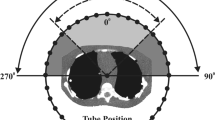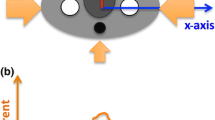Abstract
Our objective was to investigate the differences in behavior of tube current modulation (TCM) techniques for thoracic CT examinations between male and female anthropomorphic phantoms. The phantoms were scanned with an automatic exposure control system in the longitudinal (z-) and angular-longitudinal (xyz-) TCM, in addition to the fixed-mA which was used as a reference. Axial dose distributions were measured at the levels of the breasts and the diaphragm, and longitudinal dose distributions were measured from the thoracic-inlet level to the diaphragm level at the center and periphery of the phantoms by use of eight solid-state detectors. Image noise was quantitatively measured continuously from the top to the bottom images of the phantoms. With the male phantom, the percentage of average absorbed dose with the xyz-TCM mode compared to the z-TCM mode was 90.2 % at the level of the nipples. This value was significantly smaller than that for the female phantom (95.6 %, P < 0.0001). With either phantom, the percentage of absorbed doses in the longitudinal direction with the xyz-TCM mode compared to the z-TCM mode at the center of the phantom was almost the same as the percent ratio at the periphery of the phantom. Therefore, the effect of xyz-TCM was less pronounced with the female phantom, especially on the reduction of the breast dose. The increase of image noise at the level of the supraclavicular fossa (in the male phantom) and at the level of the diaphragm (both phantoms) could not be avoided with the use of TCM techniques.













Similar content being viewed by others
References
Tack D, De Maertelaer V, Gevenois PA. Dose reduction in multidetector CT using attenuation-based online tube current modulation. AJR Am J Roentgenol. 2003;181:331–4.
Kalra M, Maher M, Toth T, Kamath R, Halpern E, Saini S. Comparison of z-axis automatic tube current modulation technique with fixed tube current CT scanning of abdomen and pelvis. Radiology. 2004;232:347–53.
Angel E, Yaghmai N, Jude CM, DeMarco JJ, Cagnon CH, Goldin JG, McCollough CH, Primak AN, Cody DD, Stevens DM, McNitt-Gray MF. Dose to radiosensitive organs during routine chest CT: effects of tube current modulation. AJR Am J Roentgenol. 2009;193:1340–5.
Tsalafoutas IA, Varsamidis A, Thalassinou S, Efstathopoulos EP. Utilizing a simple CT dosimetry phantom for the comprehension of the operational characteristics of CT AEC systems. Med Phys. 2013;40:111918.
Papadakis AE, Perisinakis K, Damilakis J. Automatic exposure control in pediatric and adult multidetector CT examinations: a phantom study on dose reduction and image quality. Med Phys. 2007;35:4567–76.
Matsubara K, Takata T, Koshida K, Noto K, Shimono T, Horii J, Yamamoto T, Matsui O. Chest CT performed with 3D and z-axis automatic tube current modulation technique: breast and effective doses. Acad Radiol. 2009;16:450–5.
Van der Molen AJ, Joemai RM, Geleijns J. Performance of longitudinal and volumetric tube current modulation in a 64-slice CT with different choices of acquisition and reconstruction parameters. Phys Med. 2012;28:319–26.
McCollough CH, Bruesewitz MR, Kofler JM Jr. CT dose reduction and dose management tools: overview of available options. Radiographics. 2006;26:503–12.
Hurwitz LM, Yoshizumi TT, Goodman PC, Nelson RC, Toncheva G, Nguyen GB, Lowry C, Anderson-Evans C. Radiation dose savings for adult pulmonary embolus 64-MDCT using bismuth breast shields, lower peak kilovoltage, and automatic tube current modulation. AJR Am J Roentgenol. 2009;192:244–53.
CIRS. User guide of adult male phantom (model 701-D). Norfolk: CIRS; 2010. p. 1–9.
CIRS. User guide of adult female phantom (model 702-D). Norfolk: CIRS; 2010. p. 1–9.
The International Commission on Radiological Protection (ICRP). Report on the task group on reference man. Ann ICRP. 1975;4:1–465.
The International Commission on Radiological Protection (ICRP). Basic anatomical and physiological data for use in radiological protection: reference values. Ann ICRP. 2002;32:1–265.
International Commission on Radiation Units and Measurements (ICRU) Report 48: Phantoms and Computational Models in Therapy, Diagnosis and Protection. Bethesda: ICRU; 1992. p. 1–194.
Herrnsdorf L, Björk M, Cederquist B, Mattsson CG, Thungström G, Fröjdh C. Point dose profile measurements using solid-state detectors in characterization of Computed Tomography systems. Nucl Instrum Methods Phys Res, Sect A. 2009;607:223–5.
International Commission on Radiation Units and Measurements (ICRU) Report 44: Tissue substitutes in radiation dosimetry and measurement. Bethesda: ICRU; 1989. p. 1–189.
Söderberg M, Gunnarsson M. Automatic exposure control in computed tomography—an evaluation of systems from different manufacturers. Acta Radiol. 2010;51:625–34.
Wang J, Duan X, Christner JA, Leng S, Yu L, McCollough CH. Radiation dose reduction to the breast in thoracic CT: comparison of bismuth shielding, organ-based tube current modulation, and use of a globally decreased tube current. Med Phys. 2011;38:6084–92.
Matsubara K, Sugai M, Toyoda A, Koshida H, Sakuta K, Takata T, Koshida K, Iida H, Matsui O. Assessment of an organ-based tube current modulation in thoracic computed tomography. J Appl Clin Med Phys. 2012;13:148–58.
Lungren MP, Yoshizumi TT, Brady SM, Toncheva G, Anderson-Evans C, Lowry C, Zhou XR, Frush D, Hurwitz LM. Radiation dose estimations to the thorax using organ-based dose modulation. AJR Am J Roentgenol. 2012;199:W65–73.
Keat N. CT scanner automatic exposure control systems, Medicines and Healthcare products Regulatory Agency (MHRA) evaluation report 05016. London: MHRA; 2005. p. 1–57.
Acknowledgments
This study was performed at Beth Israel Deaconess Medical Center, Harvard Medical School, Boston, Massachusetts, under the educational and research training exchange program of the Japanese Society of Radiological Technology.
Conflict of interest
All of the authors who contributed to the work have no conflict of interest.
Author information
Authors and Affiliations
Corresponding author
About this article
Cite this article
Matsubara, K., Lin, PJ.P., Fukuda, A. et al. Differences in behavior of tube current modulation techniques for thoracic CT examinations between male and female anthropomorphic phantoms. Radiol Phys Technol 7, 316–328 (2014). https://doi.org/10.1007/s12194-014-0269-y
Received:
Revised:
Accepted:
Published:
Issue Date:
DOI: https://doi.org/10.1007/s12194-014-0269-y




